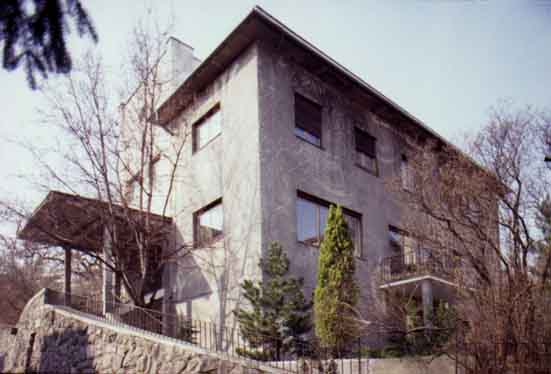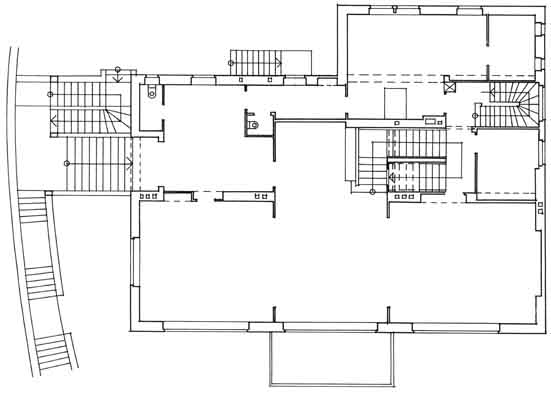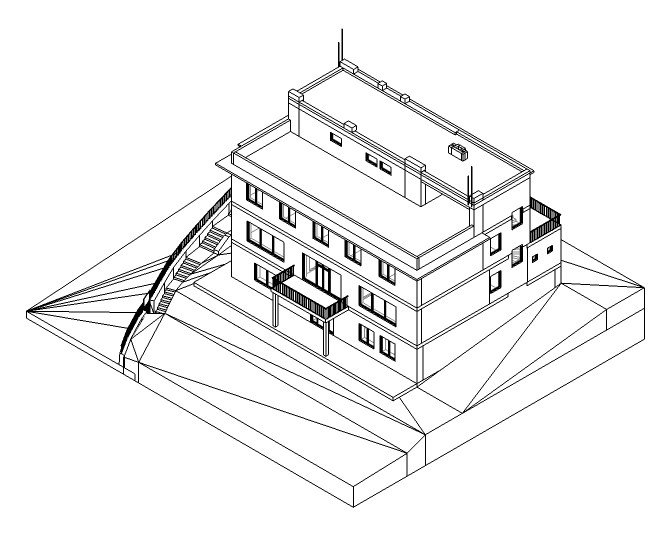| address architects interior design realization |
Podtatranského 3, Bratislava Fridrich Weinwurm, Ignác Vécsei Josef Hoffman 1929 |
At the time when the Slovak Builder magazine in its first edition year of 1931 published an article about the new upscale residential district on Bratislava's Hausbergl, the architects Frederick Weinwurm and Ignac Vecsei were the most renowned architects in town. Due to their excellent reputation the author of the article among other things refered to their earlier project, a villa for a prominent Bratislava lawyer Arpad Lengyel. He described it as “a very handsome, efficient” villa with a “perfect floor plan layout” which was “one of the most modern in the city”. The architect's design of the villa was shaped as a simple cuboid partially sunk into the grade of the exposed lot. The villa has three floor levels: a basement, a raised ground floor and an upper floor. The main entrance to the house is accessed through a generous two-flight outdoor staircase, which nearing the entrance is sheltered with a prominent steel-reinforced concrete canopy. The ground floor used as the main living floor has an open concep. On the upper floor, there are bedrooms of family members, washrooms and a terrace accessible from a common hall. The architecture of the villa bears the characteristics of a purist modernism: a smooth minimalist facade and a spacious, efficiently arranged interior. Characteristic for the works of architects Weinwurm and Vecsei, it is moderate and outwardly very unassuming in appearance for a luxury mansion. This restrained looks was due to their rejection of showy architectural gestures and their orientation to practical and durable architecture.
Architects Weinwurm and Vecsei became famous thanks to their residential building designs. They could handle a layout of any smallest apartment just as well as high-end residences for the cream of the crop. Their mastery was proven once again in Dr. Lengyel's villa. Their concept arises from subdividing the interior into three quarters: public, private and service. Thus, they not only succeeded in respecting all principles of functional segregation of modern residential buildings but at the same time managed to create a generous, yet flexible and highly functional space with a logic setup.
As a passionate promoter of “straightforwardness” Frederick Weinwurm was against all that was inefficient and the architectural form was to strictly reflect the inherent operation of the house. Thus in their work as a pair, Weinwurm and Vecsei sought to eliminate all pretence and inefficiency. The result were stark architectural forms with smooth facades devoid of decoration and clear-cut flat roofs. A wide attention in their work was granted to the latest achievements in modern construction industry – steel and concrete structures and patented steel window frames which were being delivered to the Czechoslovak market by the company of A. Kraus from Bratislava.
Perhaps it was the austerity of the villa that led the owner to hiring the famous Viennese architect Josef Hoffman to finish the interiors. He designed a complete interior package for the villa, substantial part of which was manufactured at the Wiener Werkstädte (Vienna Workshops). Selecting a different architect to furnish the house, however, may well have been the result of an arrangement between the original architect and the owner. Such a procedure was not uncommon at the time, on the contrary, it occurred quite frequently. Certain tension that arose between the purist structure and the rich and decorative interior made name for the villa, and thanks to this it became a legendary example of the contradictions between modernism and tradition.
Literature:
Nová vilová štvrť v Bratislave. Slovenský staviteľ 1, 1931, p. 91 – 95.
Foltyn, Ladislav: Slovenská architektúra 1918 – 1938 a česká avantgarda. Bratislava, SAS 1993.
Sekler, Eduard F.: Josef Hoffmann. Das architektonische Werk. Wien, Residenz Verlag 1986, p. 206 and 417.
Holčík, Štefan: Hoffmann v Bratislave. Designum 1998, 2, p. 35.
Moravčíková, Henrieta: Koncepcie a typy bývania. Slovensko medzi dvoma vojnami. In: Bývanie v premenách času. Stupava, Orgware 1998.
Dulla, Matúš – Moravčíková, Henrieta: Architektúra Slovenska v 20. storočí. Bratislava, Slovart 2002, p. 96 – 97.
Moravčíková, Henrieta: Dva modely prijímania moderny na Slovensku: Fridrich Weinwurm a Christian Ludwig. Architektúra & Urbanizmus 40, 2006, 3 – 4, p. 131 – 154.
Photo:
Matúš Dulla
Ground plan:
Department of Architecture Archive, ÚSTARCH SAV
This model was made possible through the financial support of the agency KEGA (modely): 003STU-4/2016



